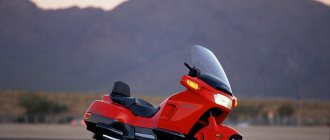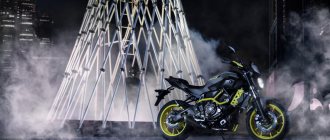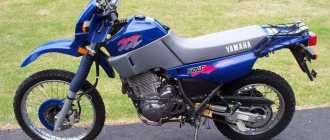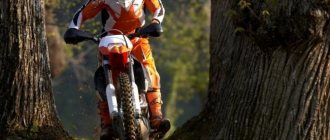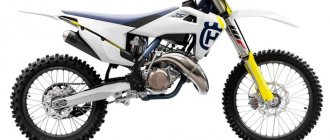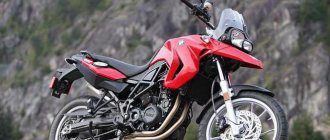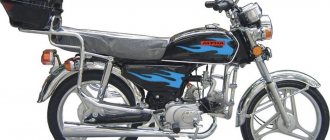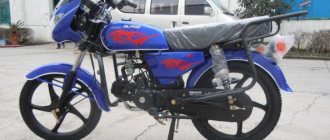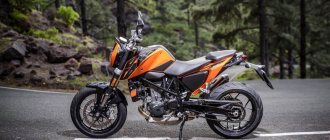The BMW F650GS, the photo of which is presented on the page, is a touring enduro motorcycle that is experiencing a rebirth. Since the market conditions for cars and motorcycles are quite unpredictable, all sorts of surprises are possible in its vastness. The German company, frightened by the decline in sales of the once popular model, curtailed production of the BMW F650GS to a minimum. All motorcycles then began to be sent to Brazil, which is considered the most attractive country in terms of selling two-wheeled sports, road-tourist and racing cars.
Loss of previous positions
However, the vacated niche was instantly occupied by Japanese motorcycles of the Yamaha XT660Z Tenere brand. The model from the Land of the Rising Sun is an absolute twin of the BMW F650GS, and its sales, although not too high, have always remained at a quite acceptable level. BMW realized their mistake, and currently the production of the F650 is gaining momentum. However, time is lost, the positions gained over the years are lost, and we have to start all over again.
There was only one way to correct the situation - to present the model’s return to the market as radically updated. In this case, a long period of absence from the motorcycle was justified. But, on the other hand, the manufacturer was responsible for a deep modernization of the car, and especially for radically improved external data.
It was necessary to present the motorcycle in a new design, different contours and outlines were needed. The bike had to become unrecognizable, of course, to a certain extent. After a number of design modifications, the model was put into production. The expectation for an update was justified - consumers believed that this was a long-familiar model, but one that had gone through a deep restyling, with a modernized chassis and an improved power plant. A slight reduction in cost was the final touch in the return of the motorcycle to the market.
Brief history of the model
Brief production history of the BMW F650:
- 1993 – start of production and sales of BMW F650 (Funduro).
- 1996 – appearance of the BMW F650ST (Strada) modification.
- 2000 - the BMW F650 and BMW F650ST models are discontinued, giving way to the new F650GS and F650CS. Sales of older versions continued until 2001.
- 2004 - F650GS and F650CS models receive 2 spark plugs instead of 1 (Twin Spark marking on the cylinder).
- 2007 is the last year of production of BMW F650 series motorcycles.
- 2008 - The BMW F650GS was replaced by an updated model with an in-line 2-cylinder engine with a displacement of about 800 cc. see and a completely different appearance (asymmetrical headlight, alloy wheels, new dashboard). It was produced until 2012 and was subsequently replaced by the BMW F700GS.
- 2009 - the appearance of the BMW G650GS model, built on the basis of the F650GS (2000-2007) and aimed at the markets of the USA, South America, Greece and Australia.
Exterior
The single-cylinder BMW F650GS motorcycle, although somewhat “thin” in appearance, still looks quite presentable. The front shield with a powerful shaped headlight ends at the top with a stylish windshield, at the bottom with a developed, pointed fender hanging over the front wheel, and the rear sides are smoothly integrated into the front of the gas tank. The compact engine almost does not protrude beyond the frame, the muffler is sort of built under the passenger seat, it is practically invisible.
The contours of the motorcycle have become more rapid, therefore, the aerodynamic parameters have also improved. However, the model does not need high speeds; the motorcycle has other tasks; it was not designed for ultra-fast riding, but is intended for off-road travel, in the forest, among the hills and in natural terrain. For such a ride, the bike tires are equipped with a special tread with a spike-like pattern. The high relief of the tires allows the motorcycle to travel through sand, clay soils, and plowed land.
Test drive BMWF 650 GS
Cats are castrated to tame their character and improve the environment. By purchasing a motorcycle, on the contrary, you want to emphasize your character, masculinity, expand the mating area and the variety of partners. Therefore, they usually choose the most charismatic, noisy, aggressive and environmentally harmful specimen. Motorcycle manufacturers understand this motivation very well.
But for some reason sometimes they do the opposite.
First gear clicks loudly, the gas is almost all the way, and... you can call for a smoke break right during acceleration. The BMW F 650 GS demonstrates the dynamics of a dead roach in the lower reaches of a sewer. The owner boasted of stunning fuel efficiency figures, and from the very first meters of the journey it becomes clear that he was not lying. An engine running on single molecules of gasoline is a priori unable to accelerate dynamically. Apparently, this is why his sound is dry, quiet and emotionally distilled. The almost complete absence of vibrations only exacerbates the feeling of spinelessness.
The motorcycle was accelerated to 160 km/h. There is no great pleasure in driving at this speed, because the chassis and suspension work at the limit and the slightest irregularities take it beyond the limits of the operating range, and the dynamics at speeds close to maximum are so sluggish that you have to plan overtaking, almost like on a budget sedan.
The Beemer's gearbox is clear and light, the gear ratios for this rather boring engine were chosen quite well, which somewhat brightens up the overall picture. Upshifts without a clutch are unclear, but this feature cannot be considered a serious drawback - the 650th “Goose” is still not a sportbike. The reaction of the gearbox to attempts to engage the non-existent “minus first” and sixth gears is interesting. Unlike some “Japanese” ones, the leg of the box does not rest against the “wall”, but falls into “nowhere”, showing the pilot that he is demanding the impossible. The German-style fuel injection system rations gasoline sparingly, allowing the bike to accelerate without jerking at a speed of 40 km/h in fifth gear. The acceleration didn’t even feel like a 400, but rather like a 250 or another two-stroke “staff”. The degree of “castration” of the F 650 GS for the sake of ecology, efficiency and gentle character is amazing. Some 400 cc enduros, which do not pretend to be any serious sportiness, accelerate faster in higher gears.
The suspension of the small “goose” is in complete harmony with the engine. She... nothing. The fork does not provide the required degree of compression damping, which is why the motorcycle bites heavily during vigorous braking, and if you catch a medium-sized hole, you can easily get a breakdown.
The monoshock absorber, unlike the non-adjustable fork, works tolerably and even allows you to change the spring preload without using a special key, which is useful when traveling with luggage and a passenger. But the owners, most likely, will not want to evaluate this opportunity, since under the weight of the “second number” and a full case, the remnants of the accelerating dynamics will be buried alive. A small bonus - the monoshock spring preload adjustment knob has “clicks”, so it will be easier to remember the setting changes.
Due to the low energy consumption of the suspension and road tire size
The F 650 GS feels uncomfortable outside of the asphalt. It will, of course, digest dry hard primer or gravel. But nothing more. On wet, dirty or loose surfaces, considerable weight, a sluggish engine and almost one hundred percent asphalt tires take their toll. If you drive standing, the situation improves a little, but you still feel with every cell of your spinal cord that you won’t be able to make a bullet from this “substance.”
The brakes deserve good words. Brembo calipers reliably and adequately slow down the motorcycle even from maximum speeds and stubbornly do not overheat. The front brake without the notorious booster allows you to accurately dose the force, which is why ABS rarely activates during non-extreme driving. If the wheels do lock, ABS quickly and proportionately prevents the development of a dangerous situation.
A huge plus of the system installed on the F 650 GS is the ability to turn it off. This is especially useful, for example, on mountain gravel roads, where anti-lock can significantly lengthen the braking distance. And in light of the fact that European legislators are seriously considering the possibility of banning manufacturers from installing switchable ABS on motorcycles, this option becomes doubly attractive.
Another joy is the consoles of a classic design. Unlike the original BMW ones (with three control buttons for turn signals), you don’t have to get used to them for several days. However, instead of turning off the turn indicators, the finger occasionally hit the horn button, which is why some drivers looked askance at the pilot as if he were a “teapot” blowing the whistle for no apparent reason.
In addition to the remote controls, I also liked the steering wheel grips with two-stage heating. They are really very comfortable. Even after a couple of hundred kilometers, the hands did not experience discomfort or fatigue, and remained warm in the cold.
An excellent saddle also contributes to this ergonomic picture, allowing it to easily cover impressive distances without developing hemorrhoids, as well as to place full feet on the asphalt even for not very tall pilots. Unfortunately, it is also convenient for the passenger, so you will have to come up with special excuses to throw the woman off the “cart.”
The “picture” is completed by a comfortable body position and wind protection. Well-placed footrests do not force even tall pilots to bend their knees excessively, the wide handlebar makes maneuvering easier and allows you to sit with a slight forward lean, and the high (optional) glass quite effectively protects from air flow.
While in the saddle, you have to look for the side stand during the day with a flashlight. The first time the process took more than a minute, but as I got used to it, the time was reduced to fifteen to twenty seconds.
But it was not possible to perfect it to the standard two-second “kick” with the left heel. The side stand folds with a loud clatter of metal on metal. There is nothing wrong with this, apparently the elastic band was just lost. The bike rises onto the central stand very easily, so even after a tedious process, placing a motorcycle on it with a loaded case will not be difficult.
Studying the functions of the dashboard took about seven and a half seconds - the device turned out to be radically ascetic. Speedometer, odometer, tachometer, clock, a set of familiar indicator lights and just one mileage counter. It is difficult to get lost in such a “forest”. The appearance of the device is unprepossessing, but the readings can be read confidently.
The designers took a non-standard approach to the location of the gas tank and its filler neck. It is located under the passenger’s right knee, and in the usual place in front of the pilot there is an oil tank cap. To check the oil level there is an inspection window located on the side of the left fork leg. But it is very difficult to see anything clearly through it.
The manufacturer positions the F 650 GS as a bike for beginner lovers of medium-sized enduros who want to get a taste of owning Bavarian equipment without the risk of being disappointed by losing an impressive amount. Unfortunately, in addition to an understandable attempt to fit within a moderate budget, by simplifying and cheapening the design, the manufacturer inadvertently cut off a piece of the “junior” “Goose”’s soul and manhood. Because of this, a wonderful device came off the assembly line for lonely 89-year-old pizza delivery people who despise the noise of engines, advocate for the environment, fuel economy and sincerely respect the peace of their neighbors. Like a eunuch in a harem, such a “Goose” does not pose a serious danger to girls.
History of the BMW F 650 GS
1994. The birth of the F 650, also known as the Funduro, is BMW's first single-cylinder chain-driven motorcycle since the R27. The device was designed jointly with Aprilia, produced at factories in Italy and turned out to be in many ways similar to the Pegaso model, which also used a 652 cm3 Rotax engine. Thanks to its excellent efficiency (4-4.5 l/100 km) and reliability (instances are known to have run more than 1,000,000 km without breakdowns), the motorcycle has won the respect of buyers. Simultaneously with Funduro, sales of the road version of the F 650 ST began.
2000. The first deep update and transformation of the Funduro into the F 650 GS. The appearance has radically changed, the motorcycle received a new frame and subframe. The fuel injection system replaced twin carburetors, the oil tank location was changed, and the gas tank was moved under the saddle. Power increased from 48 to 50 hp. A version with ABS appeared, as well as a Dakar model. The production of the motorcycle was moved to Germany.
2004. The appearance of a model with two spark plugs and slightly modified timing parts.
2006. The birth of the BMW G 650. Despite the fact that these motorcycles are not real “F 650s”, they are in many ways similar to them, using the same Rotax engine, now developing 53 hp, a fuel tank reduced to 9.5 liters and have significantly less weight (156 kg versus 192 kg).
2008. Stopping supply of the single-cylinder F 650 GS to all countries (except Brazil and a couple of countries in South America) and starting production of the 798cc parallel-twin bike. Despite the increased displacement, the device retains the model name “F 650 GS”.
2009. BMW has relaunched the single-cylinder F 650 GS as the G 650 GS for the USA, South America, Greece and Australia. In essence, the new model turned out to be an exact copy of the 2007 F 650 GS, but the Austrian-assembled engine gave way to a power unit assembled in China from Rotax components.
2010. The G 650 GS is available worldwide. Power dropped to 47 hp.
2012. Start of sales of the G 650 GS Sertao model, with a different appearance and more suitable for off-road use.
Text: Anton Barsukov
Photo: Victor Akilov and the author
New name and improved parameters
Sertao – this is the name the motorcycle received in addition to the abbreviation BMW F650GS. The new modification is significantly different from the previous version of Dakar, which represented the family of SUVs in full. Sertao is more modest, he prefers an asphalt surface, but if necessary, he can fit into the narrowest crack. The latest BMW F650GS features spoked wheels, increased suspension travel, higher ground clearance and a raised saddle, which improves the rider's riding position.
It is characteristic that, despite the increased growth of the car, its center of gravity remained at the same level, quite low, from the point of view of entering turns and sharp turns. In principle, BMW models have long proven themselves to be stable and easy to drive, which allows them to confidently maneuver between trees and jump along the very edge of the curb. Although the saddle is raised, the rider can reach the ground with his feet, and this is an additional advantage when riding in the “enduro” style.
Advantages
When it comes to the advantages of the BMW F650GS, we would like to focus on the braking system, which demonstrates excellent feedback and good deceleration. The front brake is activated very rarely, thanks to the correct dosage of the applied force. The presence of ABS means that in the event of wheel locking, the system will help avoid a dangerous situation.
Prudent designers made it possible to completely disable ABS. With the system deactivated, it is easier to climb a mountain or overcome sections of the road without asphalt. One thing to consider is that with ABS turned on, your braking distance will be much shorter. European organizations have long proposed a ban on the installation of ABS with the possibility of turning it off. So the owners of this BMW received a nice bonus.
The design of the remotes deserves a positive assessment, which is incredibly simple and has nothing superfluous, allowing the biker to quickly understand the device. The remote control has only three buttons, like other motorcycles of this German brand. However, there have been cases when an inexperienced biker got confused even with this simple device and instead of pressing the button to turn off the turn indicators, he pressed the horn button. The motorcycle automatically turns on the horn, which can not only confuse you, but also greatly frighten you.
A pleasant and useful additional feature is the heated steering wheel grips. This will make your trip as comfortable as possible, especially in spring or autumn, as well as in mountainous areas where the air does not warm up even in the summer.
The seat is wide and comfortable. Many owners note that even after traveling long distances they did not experience fatigue or pain in the buttocks. The seating position is as low as possible, which makes the motorcycle attractive for short people. The position of the footrests is extremely good; even a tall biker will not have to bend his knees. The steering wheel is wide, allowing excellent maneuvering and keeping your hands in a comfortable position, which is important from the point of view of comfort. The windshield is high and wide. It will reliably protect the motorcyclist from oncoming air currents and midges.
Is ABS really necessary?
In a peak situation, you can create additional support by placing your foot on the ground and drive out of the dangerous area. The motorcycle is equipped with an ABS system, although it is not customary to equip SUVs with anti-lock brakes (it is believed that it is not needed in off-road conditions). However, the option is installed. However, the ABS system can be turned off; there is a special button located on the steering wheel for this. It all depends on the riding style of each individual motorcyclist. Some people are used to skidding and sliding tangentially, while others, on the contrary, prefer to drive in a straight line. In the latter case, ABS can be useful.
New opportunities
Overall, the BMW F650GS Sertao turned out to be a versatile motorcycle, capable of both long journeys and short bursts off-road. He can turn into a cross-country sprinter or ride several hundred kilometers without stopping. The disadvantages of the BMW F650GS include the lack of a trunk and any brackets for securing things.
However, this problem can be solved on its own, since both sides of the rear of the motorcycle are free - there is practically no muffler, it is hidden under the seat.
What changed
The motorcycle is equipped with new spoked wheels and also has a different body color. It is thanks to the black and gray color in which the Sertao is painted that the bike has a more aggressive appearance. The suspension has received more travel, as well as stiffer settings, which significantly improves off-road maneuverability and maneuverability. Especially for extreme sports enthusiasts, it became possible to install auxiliary (additional) equipment.
As a rule, the engine installed is the same as on the classic F650GS, but for some countries a less powerful modification will be produced, the engine of which can produce only 34 hp. With. The braking system also remains the same, ABS can be turned off.
BMW F650GS: technical specifications
Dimensional and weight parameters:
- motorcycle length – 2165 mm;
- total height – 1390 mm;
- width along the steering wheel – 920 mm;
- height along the saddle line – 780 mm;
- height along the saddle line of the latest model – 820 mm;
- wheelbase, distance between axles – 1710 mm;
- curb weight of the fueled motorcycle – 192 kg;
- dry weight – 175 kg;
- weight in standard configuration – 188 kg;
- fuel tank capacity – 14 liters;
- reserve volume – 4.0 liters.
Dashboard
The dashboard is classic. Only important information is displayed on it, which is perfectly readable even in direct sunlight, allowing the biker to better concentrate on the road. On the instrument panel we will find:
- Speedometer.
- Odometer.
- Distance meter.
- Indicators for gasoline, engine temperature, turns, etc.
- Tachometer.
- Watch.
A distinctive feature is the non-standard location of the fuel tank, which is located on the right side of the passenger seat.
Power point
- Engine type: single-cylinder, four-stroke.
- Number of valves – 4.
- The number of camshafts is two, with an overhead arrangement.
- The lubrication system is crankcase.
- Cylinder diameter – 100 mm.
- The piston stroke is 83 mm.
- Number of spark plugs – 2.
- Working cylinder volume – 652 cubic meters. cm.
- Power – 48 l. With. (35 kW) at 6,500 rpm.
- Power supply – injection injection of a combustible mixture with electronic dosage.
- Exhaust gas purification - three-level neutralization, catalyst according to Euro-3 standard.
- Cruising range – 450 kilometers at a speed of 90 km/h.
- Fuel type – unleaded gasoline AI 95.
- Gasoline consumption is 3.2 liters at a speed of 90 km/h and 4.3 liters at 120 km/h.
Chassis
- The frame is tubular, made of drawn steel, of complex profile with shockproof protective elements.
- Front suspension: reverse telescopic fork with damper. Stays with a diameter of 41 mm with built-in hydraulic shock absorbers.
- The rear suspension is of an articulated pendulum design, a fork cast from an aluminum alloy with adjustable spring support and hydraulic shock absorbers.
- The travel amplitude of the front suspension is 180 mm.
- The swing of the rear suspension pendulum is within 170 mm.
- The wheels are spoked, the rim is made of light aluminum alloy.
- The dimensions of the front wheel are 2.50x19″.
- Rear wheel size – 3.50x17″.
- Front tire – 110/80-19 59N.
- Rear tire – 140/80-17 69N.
- The front brake is disc, diameter 300 mm, two-piston caliper.
- rear brake – disc, diameter 265 mm, single caliper, monopiston.
Transmission
- Gearbox – five-speed with cam clutches, synchronized, integrated.
- Switching - foot, lever.
- The gear ratios are selected in such a way that the motorcycle moves confidently in first, second and third gears at low speed on any road or off-road surface. And only when you turn on fourth speed, the possibility of dynamic driving becomes possible.
- The clutch is multi-disc in an oil bath, the drive is mechanical, designed on the basis of a flexible cable. The clutch lever is located on the left side of the steering rod.
- The rear wheel drive is chain.
User manual
After returning to large-scale production of the motorcycle, an instruction manual for the BMW F650GS was published, which outlined the basic rules for using the machine, all adjustments and settings that do not require special tools. The manual outlined in detail the step-by-step steps for self-service of the motorcycle. The BMW F650GS model, reviews of which were previously general in nature, has now, thanks to the instructions, become more understandable and accessible. Along with the manual, the machine was supplied with a small set of tools with which it was possible to make simple adjustments to the mechanisms, as well as preventive tightening of threaded connections.
Note for beginners
However, do not write off the BMW F650GS, as it has all the necessary characteristics for beginners, which many of its analogues cannot boast of. By choosing this “Bavarian horse” for yourself, you will learn to control the motorcycle, plan and overtake competently, and develop a reaction. Let's take a closer look at the characteristics of the BMW F650GS and its features so that we can get a proper idea of the motorcycle.
Owners' opinion
You can learn about the technical advantages and disadvantages of the F650GS series motorcycle by reading the numerous responses from its owners. The model is considered largely controversial. Some owners believe that the engine is not powerful enough, and therefore the biker feels insecure in urban conditions when he gets into traffic. Others, on the contrary, are dissatisfied with the excessive “gluttony” of the motorcycle - when driving at speeds exceeding 160 kilometers per hour, fuel consumption is about six liters per hundred kilometers.
Both are right, since each owner assesses the situation in his own way. Therefore, the BMW F650GS motorcycle, reviews of which vary, is liked by some and not by others. But in general, the characteristics of the German two-wheeled car suit most owners. And if bikers are asked to choose a motorcycle again, many will name the BMW F650GS model. Owner reviews are a subjective concept, since there are no ideal technical means of transportation. But still, there are main, indisputable advantages that should guide you when choosing a bike.
There are no differences in motorcycle configurations. Only one standard is used, which provides a minimum of tools, a pump, a few spare bulbs and a removable fuel filter.

